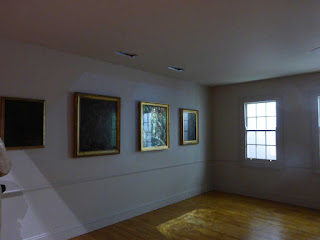 |
| Portrait of William Blake 1802.Collection Robert N. Essick |
When William Blake mounted his one and only independent exhibition
of his paintings in 1809, in a room above his family’s hosiery shop in Soho, the
critic Robert Hunt (brother of the more famous Leigh) wrote that the works were
“the ebullitions of a distempered brain” and that Blake himself was “an
unfortunate lunatic”. Not a single one was sold.
What a contrast with this new, sweeping show at Tate
Britain which takes more than 300 of his images, lent from all over the world, and illustrates how he was a
product of his tumultuous times, surrounded by revolution, war and radical
politics. His artistic career began fairly conventionally, with drawing
lessons, an apprenticeship as an engraver and enrolment as a student at the
Royal Academy of Arts, where he was encouraged to copy antique sculptures and
seek inspiration from Renaissance artists such as Michaelangelo and Raphael. But
as the exhibition shows he soon rejected the rigid ideas being taught at the
time and pursued a more personal vision.
 |
| William Blake Albion Rose c. 1793 Courtesy of the Huntington Art Collections |
It opens with his Albion Rose, c 1793,
a visualisation of the founding of Britain, created in contrast to the
commercialisation and austerity of the times, then follows his career through
to his death in 1827, at the age of 69. He never earned much, but his engraving
provided a basic income, and around 1788 he invented a new form of printmaking,
‘relief etching’. His exact methods are still unknown, but the process allowed
him to print in colour and combine texts and images. He created a succession of
visionary books which took in the most pressing moral and political questions
of the day. The exhibition curators
point out that luckily few people saw these books, and the symbolism in them
was obscure – if they’d come to the notice of the authorities, Blake might have
been arrested because of their radical sentiments.
Some of these volumes –
including Songs of Innocence and Experience – are displayed in cases, enabling visitors
to get a close look at the intricate detail surrounding what are now among his
best-known works, including The Tyger (above) and its sister poem, The Lamb. Throughout
his life Blake depended on the support of family and friends, including his
wife, Catherine, who hand-coloured some of the engravings. He had an ocasionally fractious relationship with his few loyal patrons. They admired his
unconventional character and independent spirit but he resented being their
employee and the advice they sometimes offered. The gallery shows the range of
his work, including watercolour illustrations of the Bible, Shakespeare and
John Milton.
 |
| William Blake The Ghost of a Flea c.1819 Private Collection |
Everywhere you are confronted with images which sprang from his
vivid imagination – who else could have conjured up the Ghost of a Flea (inspired
by a séance-induced vision) or Nebuchadnezzar, crawling along with terrified
eyes?
There’s also a recreation of that
first exhibition (above), which was in a small, bare, dimly lit room. Blake, understandably,
was bitterly disappointed at its failure, and withdrew from the public gaze for
several years. But in 1818, encouraged by some younger and more business-savvy
artists, he experienced a late burst of
creativity. This produced his illustrations for Pilgrim’s Progress and the poem
that has become almost a national anthem, Jerusalem.
 |
| William Blake Jerusalem, plate 28, 1820 Yale Center for British Art (New Haven, USA) |
He died while working on
his final commission, illustrations for Dante’s Inferno, with Catherine, as
ever, at his side. In 1957 a memorial to Blake and his wife was erected in
Westminster Abbey.
 |
| William Blake Catherine Blake 1805 Tate. Bequeathed by Miss Alice G.E. Carthew 1940 |
The exhibition is being described as rediscovering Blake for
the 21st century, and a once-in-a-generation event. (The last major
showing of his works was at Tate Britain in 2000.) It may be another 20 years
before his work is again displayed in such a comprehensive way.
 |
| William Blake Newton 1795c.- 1805 Tate |
William Blake is at Tate Britain until February 2, 2020. £18 (concessions available).



No comments:
Post a Comment